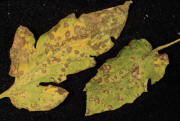|
COLUMN
 Tomato diseases and ticks Tomato diseases and ticks
By John
Fulton, University of Illinois Extension
 Send a link to a friend
Send a link to a friend
[August
21, 2013]
It seems like the tomato is the
one plant that just about everybody tries to grow. Some people grow
large amounts, while others plant one or two in containers. At any
rate, the calls and samples have started coming in to the office
with the recent swings in weather. Most of the samples have spots,
brown leaves and dropping leaves, or all of the above.
|
 Several diseases hit tomatoes, but two of the more common ones
are early blight and septoria leaf spot. Blossom-end rot seems
has also accelerated with the drier weather pattern returning,
particularly with plants grown in containers and hanging
baskets. Several diseases hit tomatoes, but two of the more common ones
are early blight and septoria leaf spot. Blossom-end rot seems
has also accelerated with the drier weather pattern returning,
particularly with plants grown in containers and hanging
baskets.
As for what to do, here is the checklist: First, keep ripe
fruits picked off the plants. Second, donít work around tomatoes
when they are wet. Next, you can try to improve air circulation,
but if your tomatoes are severely affected, you wonít want to
lose any more leaves. And the final step for this year is to try
a fungicide. Mancozeb is probably the recommended one, but it is
very hard to find. The other options are Daconil and maneb,
which are easier to find but probably wonít control as well. The
final step for future years is to practice at least a three-year
rotation with good sanitation in the garden.

Blossom-end rot is a non-pathogenic disease that is very
common during extended dry periods. It begins as a light tan
water-soaked lesion on the blossom end of the fruit. The lesions
enlarge and turn black and leathery. This can drastically lower
the yield and lower marketability of the fruits. The major
causal factors are fluctuating soil moisture supply during the
dry periods and low calcium levels.
Control of blossom-end rot consists of providing adequate
moisture from fruit formation to maturity and use of mulch
(grass clippings, plastic, straw, shredded newspapers or
plastic) to conserve moisture. The key is to provide even
amounts of moisture -- not soaked, then dry.
Ticks
Tick numbers seem to be off the chart again this year. Anyone
who has been out in tall grass or wooded areas can probably
attest to that. Probably the frequent spring rains in much of
the state have provided the high moisture and humidity that
ticks need.
Ticks are large, flattened mites that feed
as parasites on mammals, birds and reptiles. They hatch from
eggs into six-legged larvae that locate hosts and feed before
dropping off the host and molting into eight-legged nymphs.
Nymphs locate hosts, feed and drop off to molt into eight-legged
adults. Adults also locate hosts on which to feed. Males may
stay on the host, mating with females coming there to feed.
Females engorge on blood to several times their original size,
drop off the host and lay hundreds of eggs. With each tick
having to find three hosts in its lifetime, many ticks starve
before reproducing, although ticks can survive for long periods
without food.
[to top of second column] |

Ticks are numerous in areas of tall grass, where humidity is high
and hosts common. Mowing greatly reduces tick numbers. When walking
or working in areas of tall grass or other areas with ticks, apply a
repellent containing about 30 percent DEET, such as Off or Cutter,
to the lower legs and pants legs. If ticks are numerous in mowed
areas, spraying carbaryl, permethrin or bifenthrin should help give
some control.
If a tick is attached, grasp the head with tweezers where the
mouthparts enter the skin, pulling slowly and consistently. The tick
will release its mouthparts and come loose. Do not handle the tick.
Good luck trying to smash a tick. Itís about like trying to flatten
a dime with a rubber mallet. Other methods such as heat and nail
polish commonly kill the tick, resulting in locked mouthparts that
remain in the wound to cause infection. A tick typically feeds for
24 hours before releasing disease organisms, so remove ticks
promptly when you find them.
Also pay particular attention to pets in wooded areas or areas
with tall grass. Use preventive products when possible. Carbaryl
dust may be used on pets and their sleeping areas to help control
ticks and fleas. For people, mosquito and tick repellents containing
DEET can be used on clothing and body parts. Permethrin can be used
on clothing only but not sprayed on the body. Be particularly
careful of permethrin around cats and dogs, as it can be lethal.
[By
JOHN FULTON,
University of Illinois Extension]

 |